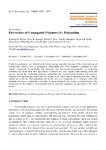Electronics of Conjugated Polymers (I): Polyaniline
| dc.contributor.author | Molapo, Kerileng M. | |
| dc.contributor.author | Ndangili, Peter M. | |
| dc.contributor.author | Ajayi, Rachel F. | |
| dc.contributor.author | Mbambisa, Gcineka | |
| dc.contributor.author | Mailu, Stephen M. | |
| dc.contributor.author | Njomo, Njagi | |
| dc.contributor.author | Masikini, Milua | |
| dc.contributor.author | Baker, Priscilla | |
| dc.contributor.author | Iwuoha, Emmanuel I. | |
| dc.date.accessioned | 2018-11-15T06:52:30Z | |
| dc.date.available | 2018-11-15T06:52:30Z | |
| dc.date.issued | 2012-12 | |
| dc.identifier.uri | ||
| dc.identifier.uri | http://ir.mksu.ac.ke/handle/123456780/1519 | |
| dc.description.abstract | Conducting polymers have elicited much interest among researchers because of their reasonably good conductivity, stability, ease of preparation, affordability and redox properties compared to other organic compounds. In particular, the electronic and electrochemical properties of conducting polymers have made them find applications in photovoltaic cells, organic light emitting diode and sensors. Among the conducting polymers, polyaniline has received much attention and intensive research work has been performed with the polymer in its native state or functionalized form. This is mainly due to the fact that polyaniline and its derivatives or composites or co-polymers with other materials are easy to synthesise chemically or electrochemically by oxidative polymerisation. The mechanism for the synthesis of polyaniline and its electronic properties are presented in this short review. | en_US |
| dc.language.iso | en_US | en_US |
| dc.publisher | International Journal of ELECTROCHEMICAL SCIENCE | en_US |
| dc.subject | Conducting polymers | en_US |
| dc.subject | Polymerisation | en_US |
| dc.title | Electronics of Conjugated Polymers (I): Polyaniline | en_US |
| dc.type | Article | en_US |
Files in this item
This item appears in the following Collection(s)
-
School of Pure and Applied Sciences [259]
Scholarly Articles by Faculty & Students in the School of Pure and Applied Sciences

